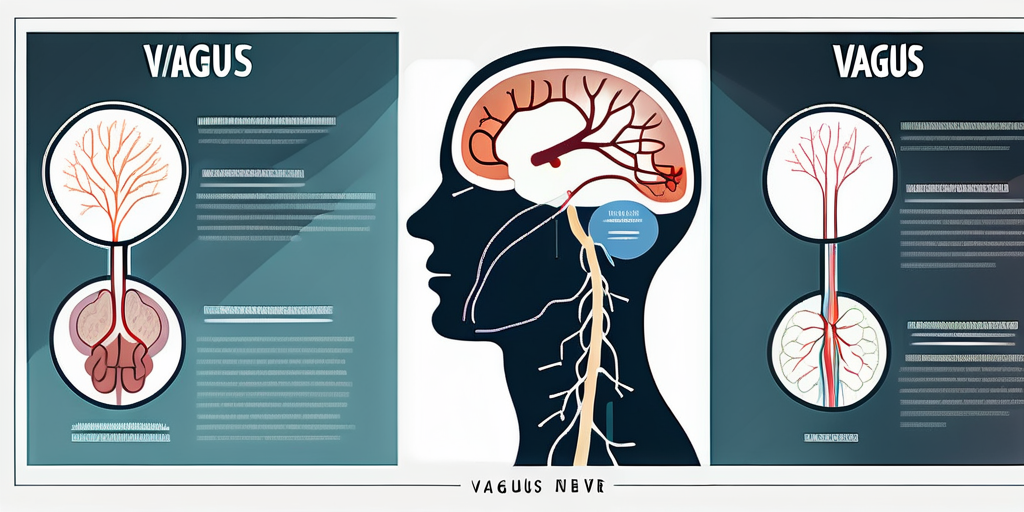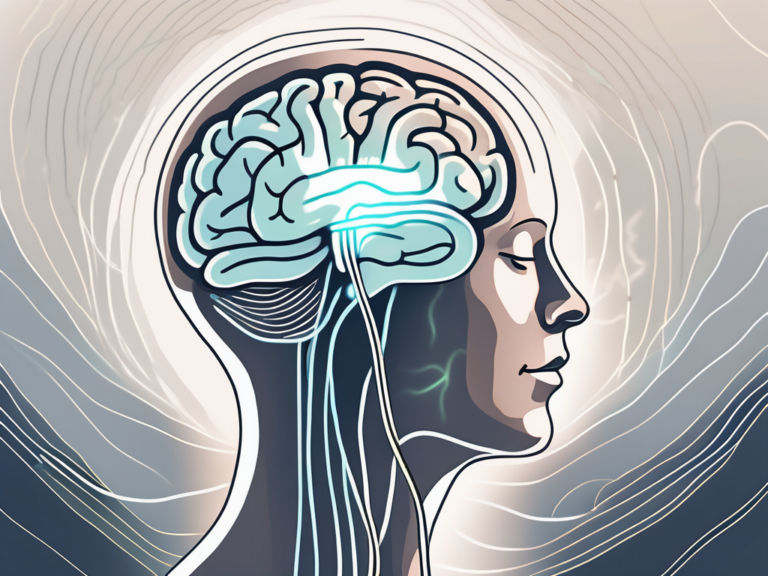guided meditation for vagus nerve
The vagus nerve is a key player in our body’s nervous system, and understanding its role can help us harness its power for our overall well-being. In recent years, guided meditation has emerged as a technique to stimulate and activate the vagus nerve, offering numerous benefits for our mental and physical health. In this article, we will explore the science behind guided meditation, techniques for stimulating the vagus nerve, incorporating meditation into your daily routine, and measuring the impact of guided meditation on the vagus nerve.
Understanding the Vagus Nerve
The vagus nerve, also known as the “wandering nerve,” is one of the largest nerves in our body. It starts in the brainstem and travels down to various organs, including the heart, lungs, stomach, and intestines. This nerve is responsible for transmitting signals between these organs and the brain, playing a vital role in regulating our body’s functions.

The Role of the Vagus Nerve in the Body
The vagus nerve plays a crucial role in maintaining our body’s balance, also known as homeostasis. It controls the parasympathetic nervous system, which is responsible for rest and relaxation. When activated, the vagus nerve slows down our heart rate, lowers blood pressure, and supports digestion and immune function.
But did you know that the vagus nerve is not just a one-way street? It’s a two-way communication highway! Not only does it transmit signals from the brain to the organs, but it also sends feedback from the organs back to the brain. This feedback loop allows our body to constantly adjust and fine-tune its responses, ensuring optimal functioning.
The Connection Between the Vagus Nerve and Mental Health
Research has shown that the vagus nerve has a strong connection to our mental health. When the vagus nerve is stimulated, it triggers the release of neurotransmitters, such as serotonin and dopamine, which play a significant role in regulating our mood and emotions.
But here’s something fascinating: the vagus nerve doesn’t just influence our mental health through neurotransmitters. It also has a direct impact on the brain’s stress response system, known as the hypothalamic-pituitary-adrenal (HPA) axis. When the vagus nerve is activated, it can dampen the HPA axis, reducing the release of stress hormones like cortisol. This mechanism helps to alleviate anxiety and promote a sense of calm and well-being.
In addition, studies have suggested that individuals with low vagal tone, meaning reduced vagus nerve activity, are more susceptible to mental health disorders, such as anxiety and depression. By stimulating the vagus nerve through guided meditation, deep breathing exercises, or even gentle electrical stimulation, we can potentially enhance our mental and emotional well-being.
So, the next time you find yourself feeling stressed or overwhelmed, remember the incredible power of your vagus nerve. By nurturing and supporting this “wandering nerve,” you can unlock a world of balance, resilience, and inner peace.
The Science Behind Guided Meditation
Guided meditation is a practice where a trained practitioner or audio recording provides instructions and visualizations to guide individuals into a state of deep relaxation. This technique combines elements of traditional meditation, such as focused breathing and mindfulness, with guided imagery to enhance its effectiveness.
But what exactly happens in the body during guided meditation? Let’s take a closer look.
How Guided Meditation Works
During guided meditation, individuals are encouraged to focus on their breath and visualize calming scenes or affirmations. This process helps shift the body from the fight-or-flight response to the rest-and-digest response, activating the parasympathetic nervous system and stimulating the vagus nerve.
The vagus nerve, also known as the “wandering nerve,” is a major player in the body’s relaxation response. It connects the brain to various organs in the body, including the heart, lungs, and digestive system. When the vagus nerve is stimulated, it releases neurotransmitters like acetylcholine, which help regulate heart rate, reduce inflammation, and promote feelings of calm and well-being.
By engaging in guided meditation regularly, we can train our body to activate the vagus nerve more efficiently, leading to improved overall well-being. It’s like giving our nervous system a gentle massage, soothing and rejuvenating it from the inside out.
Benefits of Guided Meditation for the Nervous System
Besides vagus nerve stimulation, guided meditation offers several benefits for the nervous system. It promotes deep relaxation, reduces stress and anxiety, improves sleep quality, and enhances focus and concentration. Regular practice can also help regulate heart rate variability, a marker of overall health and resilience to stress.
But that’s not all. Did you know that guided meditation can also have a positive impact on brain structure and function? Research has shown that regular meditation practice can increase the thickness of the prefrontal cortex, the part of the brain responsible for executive functions such as decision-making, problem-solving, and emotional regulation.
Furthermore, studies have found that meditation can lead to changes in the amygdala, a region of the brain involved in processing emotions. Through regular practice, individuals may experience reduced reactivity to stressors and improved emotional well-being.
So, the next time you engage in guided meditation, know that you are not only giving yourself a moment of relaxation but also nurturing your nervous system and promoting a healthier brain. It’s a powerful practice with far-reaching benefits.
Guided Meditation Techniques for Stimulating the Vagus Nerve
There are various techniques you can incorporate into your guided meditation practice to specifically target and stimulate the vagus nerve.
The vagus nerve, also known as the “wandering nerve,” is the longest cranial nerve in the body. It plays a vital role in regulating our autonomic nervous system, which controls functions such as heart rate, digestion, and stress response. By stimulating the vagus nerve, we can activate the body’s relaxation response, leading to a sense of calm and well-being.
Breathing Exercises and Their Impact
Deep diaphragmatic breathing, commonly known as belly breathing, is a powerful technique to activate the vagus nerve. By taking slow, deep breaths, inhaling through the nose and exhaling through the mouth, we engage the diaphragm and stimulate the vagus nerve.
As we breathe deeply, the diaphragm moves downward, massaging the vagus nerve and sending signals to the brain to activate the parasympathetic nervous system. This response helps to counteract the effects of stress and promotes a state of relaxation.
In addition to belly breathing, alternate nostril breathing and resonance breathing are other effective techniques to enhance vagal tone and promote relaxation. Alternate nostril breathing involves closing one nostril while inhaling and exhaling through the other, which helps balance the flow of energy in the body. Resonance breathing, on the other hand, focuses on extending the exhalation phase to activate the vagus nerve even further.
Visualization Techniques for Vagus Nerve Stimulation
Guided meditations often incorporate visualizations to help stimulate the vagus nerve. These visualizations may involve imagining a healing light or picturing oneself in a serene natural setting. The power of visualization lies in the mind-body connection, as our thoughts can influence our physiological responses.
By allowing the mind to envision calming scenes, we can activate the vagus nerve and promote a state of deep relaxation and tranquility. As we immerse ourselves in these visualizations, our bodies respond by releasing endorphins and reducing the production of stress hormones, leading to a sense of inner peace and well-being.
It is important to note that while these techniques can be beneficial for most individuals, it is always best to consult with a healthcare professional before incorporating them into your routine, especially if you have any underlying medical conditions.
So, the next time you engage in guided meditation, remember to focus on your breath and incorporate visualizations that stimulate the vagus nerve. By doing so, you can tap into the power of this remarkable nerve and experience a profound sense of relaxation and rejuvenation.
Incorporating Guided Meditation into Your Daily Routine
Integrating guided meditation into your daily routine can provide consistent benefits for the vagus nerve and overall well-being. Finding the best times to practice and creating a calm environment are key to establishing a sustainable meditation practice.

Best Times for Guided Meditation
While there is no “one-size-fits-all” answer, finding a time when you can dedicate your focus and energy to meditation is essential. Some individuals prefer morning meditation to start their day with clarity and calmness, while others find evening meditation helpful for winding down and promoting restful sleep.
Experiment with different times of the day and observe how your body and mind respond to find the best meditation schedule for you.
Creating a Calm Environment for Meditation
Choose a quiet and peaceful space where you can fully immerse yourself in the guided meditation practice. This could be a dedicated meditation room, a cozy corner in your home, or even outdoors surrounded by nature.
Dim the lights, play soft music, or incorporate calming scents such as lavender to further enhance the meditative atmosphere. Creating a serene environment helps signal to your mind and body that it is time to relax and activate the vagus nerve.
Imagine yourself in a tranquil room, adorned with soft, earth-toned decorations that evoke a sense of serenity. The walls are painted in soothing shades of blue, reminiscent of a calm ocean. As you settle into your meditation space, you notice a gentle breeze flowing through an open window, carrying with it the sweet scent of blooming flowers.
You take a moment to arrange plush cushions and blankets, creating a cozy nest where you can comfortably sit or lie down during your meditation practice. The room is filled with natural light, casting a warm glow that envelops you in a comforting embrace.
You decide to incorporate a small fountain into your meditation space, its gentle trickling sound serving as a soothing backdrop to your practice. The sound of water transports you to a peaceful oasis, allowing your mind to effortlessly drift into a state of relaxation.
As you begin your guided meditation, you close your eyes and take a deep breath, inhaling the calming aroma of lavender that fills the air. The scent instantly transports you to a field of blooming lavender, where the gentle breeze carries away any lingering tension or stress.
With each breath, you feel your body and mind becoming more attuned to the present moment. The combination of a serene environment, soothing scents, and calming sounds helps you effortlessly enter a state of deep relaxation, allowing the benefits of guided meditation to unfold.
Measuring the Impact of Guided Meditation on the Vagus Nerve
While the effects of guided meditation on the vagus nerve might not be easily measurable, there are certain physical signs and emotional benefits that can indicate improved vagus nerve function.

Physical Signs of Improved Vagus Nerve Function
Individuals with optimized vagus nerve activity often experience reduced heart rate, lower blood pressure, and improved digestion. They may also notice a decrease in symptoms related to stress, such as tension headaches or muscle tightness.
Emotional and Psychological Benefits of Vagus Nerve Stimulation
By enhancing vagal tone, guided meditation can cultivate a sense of calmness, emotional stability, and increased resilience to stress. Individuals may find themselves better equipped to handle challenging situations, experiencing greater clarity of mind and a more positive outlook on life.
But what exactly is the vagus nerve and why is it so important? Well, the vagus nerve is the longest cranial nerve in the body, extending from the brainstem to the abdomen. It plays a crucial role in regulating various bodily functions, including heart rate, digestion, and even mood. When the vagus nerve is functioning optimally, it promotes a state of relaxation and balance in the body.
Now, you might be wondering how guided meditation specifically targets the vagus nerve. During guided meditation, individuals are guided through a series of relaxation techniques, deep breathing exercises, and visualization exercises. These practices help activate the parasympathetic nervous system, which is responsible for promoting rest and relaxation. As a result, the vagus nerve is stimulated, leading to a cascade of positive effects throughout the body.
It’s important to note that each individual’s response to guided meditation may vary, and consistent practice is key to maximize the benefits for the vagus nerve and overall well-being.
In conclusion, guided meditation offers a powerful tool for stimulating and activating the vagus nerve. By understanding the science behind guided meditation, exploring various techniques for vagus nerve stimulation, incorporating it into our daily routines, and recognizing its impact on our physical and emotional states, we can harness the power of the vagus nerve for our overall well-being. So, take some time each day to nourish and care for your vagus nerve through the practice of guided meditation, and enjoy the many benefits it has to offer.






